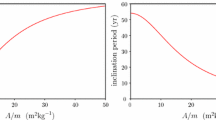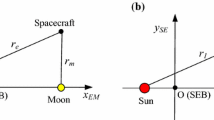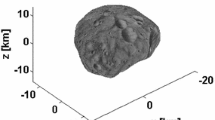Abstract
Resident space object population in highly elliptical high perigee altitude (> 600 km) orbits is significantly affected by luni-solar gravity. Using regularization, an analytical orbit theory with luni-solar gravity effects as third-body perturbations in terms of Kustaanheimo-Stiefel regular elements is developed. Numerical tests with different cases resulted in good accuracy for both short- and long-term orbit propagations. It is observed that the luni-solar perturbations affect the accuracy of the analytical solution seasonally. The analytical theory is tested with the observed orbital parameters of the few objects in highly elliptical orbits. The analytical evolution of osculating perigee altitude is found to be concurrent with observed data. Solar perturbation, when compared with lunar perturbation, is established to be dominant over such orbits.
Similar content being viewed by others
Change history
11 February 2022
A Correction to this paper has been published: https://doi.org/10.1007/s42064-022-0136-2
Abbreviations
- a :
-
semi-major axis (km)
- E :
-
generalized eccentric anomaly (°)
- E 0 :
-
initial generalized eccentric anomaly (°)
- E f :
-
final generalized eccentric anomaly (°)
- E K :
-
eccentric anomaly (°)
- e :
-
eccentricity
- L, H, D :
-
length, height, and diameter of the resident space object (m)
- h :
-
altitude (km)
- h p :
-
perigee altitude (km)
- I :
-
inclination (°)
- L(u):
-
Kustaanheimo—Stiefel matrix
- M :
-
mean anomaly (°)
- P n :
-
Legendre polynomial of degree n
- r :
-
radial distance (km)
- r :
-
position vector (km)
- r K :
-
magnitude of the third-body position vector (km)
- r K :
-
third-body position vector (km)
- \({\rm{\dot r}}\), v :
-
velocity vector (km)
- s :
-
fictitious time
- t :
-
physical time (s)
- u :
-
Kustaanheimo—Stiefel position vector
- (u 1, u 2, u 3, u 4):
-
components of the Kustaanheimo—Stiefel position vector/Kustaanheimo—Stiefel variables
- u* :
-
Kustaanheimo—Stiefel velocity vector
- V :
-
perturbing potential
- V K :
-
perturbing potential of the third-body
- w :
-
angular frequency
- ω K :
-
natural frequency
- (x, y, z):
-
position vector components (km)
- (x K, y K, z K):
-
position vector components of the third-body (km)
- (x M, y M, z M):
-
position vector components of the Moon (km)
- (x S, y S, z S):
-
position vector components of the Sun (km)
- α 1, β :
-
Kustaanheimo—Stiefel regular elements
- (α 1, α 2, α 3, α 4, β 1, β 2, β 3, β 4,):
-
Kustaanheimo—Stiefel regular elements
- \({\cal B}\) :
-
bilinear relation
- κ :
-
frequency ratio
- ω :
-
argument of perigee (°)
- Ω :
-
right ascension of the ascending node (°)
- ϕ :
-
angle between the third-body and RSO vector in inertial geocentric equatorial coordinates (°)
- σ :
-
intermediate angular variable (°)
- τ :
-
time element
- μ :
-
standard gravitational parameter of the Earth (km3 · s−2)
- β S :
-
standard gravitational parameter of the Sun (km3 · s−2)
- μ M :
-
standard gravitational parameter of the Moon (km3· s−2)
- *:
-
derivative with respect to E
- ′:
-
derivative with respect to s
- T:
-
matrix transpose
- osc:
-
osculating element
- LEO:
-
low Earth orbit
- MEO:
-
medium Earth orbit
- GEO:
-
geosynchronous orbit
- TLE:
-
two line element
- RSO:
-
resident space object
- HEO:
-
highly elliptical orbit
- KS:
-
Kustaanheimo—Stiefel
- RK:
-
Runge—Kutta
- SDP4:
-
simplified fourth-order deep space perturbations
- GB:
-
giga bytes
- RAM:
-
random access memory
- FORTRAN:
-
formula translation
- CPU:
-
central processing unit
References
Cook, A. Success and failure in Newton’s lunar theory. Astronomy and Geophysics, 2000, 41(6): 6.21–6.25.
Upton, E., Bailie, A., Musen, P. Lunar and solar perturbations on satellite orbits. Science, 1959, 130(3390): 1710–1711.
Rex, D., Bendisch, J., Flury, W., Klinkrad, H. The ESA space debris mitigation handbook. Advances in Space Research, 1999, 23(1): 215–225.
Kozai, Y. On the effects of the Sun and the Moon on the motion of a close-Earth satellite. Smithsonian Contributions to Astrophysics, 1963.
Blitzer, L. Lunar-solar perturbations of an earth satellite. American Journal of Physics, 1959, 27(9): 634–645.
Cook, G. E. Luni-solar perturbations of the orbit of an earth satellite. Geophysical Journal of the Royal Astronomical Society, 1962, 6(3): 271–291.
Kaula, W. M. Development of the lunar and solar disturbing functions for a close satellite. The Astronomical Journal, 1962, 67: 300.
Kozai, Y. A new method to compute Lunisolar perturbations in satellite motions. Smithsonian Contributions to Astrophysics Special Report, 1973: 235.
Giacaglia, G. E. O. Lunar perturbations of artificial satellites of the earth. Celestial Mechanics, 1974, 9(2): 239–267.
Hough, M. E. Orbits near critical inclination, including lunisolar perturbations. Celestial Mechanics, 1981, 25(2): 111–136.
Xu, G. C., Xu, T. H., Yeh, T. K., Chen, W. Analytical solution of a satellite orbit disturbed by lunar and solar gravitation. Monthly Notices of the Royal Astronomical Society, 2011, 410(1): 645–653.
Solórzano, C. R. H., de Almeida Prado, A. F. B. Third-body perturbation using a single averaged model: Application in nonsingular variables. Mathematical Problems in Engineering, 2007, 2007: 1–14.
Lara, M., San-Juan, J. F., Loópez, L. M., Cefola, P. J. On the third-body perturbations of high-altitude orbits. Celestial Mechanics and Dynamical Astronomy, 2012, 113(4): 435–452.
Colombo, C. Long-term evolution of highly-elliptical orbits: Luni-solar perturbation effects for stability and re-entry. Frontiers in Astronomy and Space Sciences, 2019, 6: 34.
Broucke, R. A. Long-term third-body effects via double averaging. Journal of Guidance, Control, and Dynamics, 2003, 26(1): 27–32.
Kustaanheimo, P., Schinzel, A., Davenport, H., Stiefel, E. Perturbation theory of Kepler motion based on spinor regularization. Journal Fur Die Reine Und Angewandte Mathematik (Crelles Journal), 1965, 1965(218): 204–219.
Stiefel, E. L., Scheifele, G. Linear and Regular Celestial Mechanics. New York: Springer-Verlag Berlin Heidelberg, 1971.
Sundman, K. F. Memoire sur le probleme des trois corps. Acta Mathematica, 1913, 36: 105–179.
Hamilton, W. R. On quaternions, or on a new system of imaginaries in algebra. The London, Edinburgh and Dublin Philosophical Magazine and Journal of Science, 1844:35.
Hopf, H. Über die abbildungen der dreidimensionalen sphare auf die kugelflache. Mathematische Annalen, 1931, 104(1): 637–665.
Sharma, R. K. Analytical integration of K-S element equations with J2 for short-term orbit predictions. Planetary and Space Science, 1997, 45(11): 1481–1486.
Sharma, R. K. Analytical approach using KS elements to near-Earth orbit predictions including drag. Proceedings of the Royal Society of London Series A: Mathematical and Physical Sciences, 1991, 433(1887): 121–130.
Sharma, R. K. A third-order theory for the effect of drag on Earth satellite orbits. Proceedings of the Royal Society of London Series A: Mathematical and Physical Sciences, 1992, 438(1904): 467–475.
Sharma, R. K. Contraction of satellite orbits using KS elements in an oblate diurnally varying atmosphere. Proceedings of the Royal Society of London Series A: Mathematical, Physical and Engineering Sciences, 1997, 453(1966): 2353–2368.
Sharma, R. K. Contraction of high eccentricity satellite orbits using K-S elements with air drag. Proceedings of the Royal Society of London Series A: Mathematical, Physical and Engineering Sciences, 1998, 454(1974): 1681–1689.
Sharma, R. K., Xavier James Raj, M. Fourth-order theories for orbit predictions for low- and high-eccentricity orbits in an oblate atmosphere with scale height dependent on altitude. Acta Astronautica, 2009, 65(9–10): 1336–1344.
Sellamuthu, H., Sharma, R. K. Orbit theory with lunar perturbation in terms of Kustaanheimo-Stiefel regular elements. Journal of Guidance, Control, and Dynamics, 2017, 40(5): 1272–1277.
Sharma, R. K. Analytical approach using KS elements to short-term orbit predictions including J2. Celestial Mechanics and Dynamical Astronomy, 1989, 46(4): 321–333.
Sharma, R. K. Analytical short-term orbit predictions with J3 and J4 in terms of KS elements. Celestial Mechanics & Dynamical Astronomy, 1993, 56(4): 503–521.
Sharma, R. K., Mani, L. Study of RS-1 orbital decay with KS differential equations. Indian Journal of Pure and Applied Mathematics, 1985, 16(7): 833–842.
Sharma, R. K., Raj, M. X. J. Analytical short-term orbit predictions with J2 to J6 in terms of KS elements. Indian Journal of Pure and Applied Mathematics, 1997, 28(9): 1155–1175.
Sellamuthu, H., Sharma, R. K. Hybrid orbit propagator for small spacecraft using Kustaanheimo-Stiefel elements. Journal of Spacecraft and Rockets, 2018, 55(5): 1282–1288.
Levi-Civita, T. Sur la résolution qualitative du problème restreint des trois corps. Acta Mathematica, 1906, 30: 305–327.
Breiter, S., Langner, K. The Lissajous-Kustaanheimo-Stiefel transformation. Celestial Mechanics and Dynamical Astronomy, 2019, 131(2): 9.
Roa, J., Urrutxua, H., Peláez, J. Stability and chaos in Kustaanheimo-Stiefel space induced by the Hopf fibration. Monthly Notices of the Royal Astronomical Society, 2016, 459(3): 2444–2454.
Roa, J. Regularization in Orbital Mechanics; Theory and Practice. Berlin/Boston: De Gruyter, 2017.
Blanco-Muriel, M., Alarcón-Padilla, D. C., López-Moratalla, T., Lara-Coira, M. Computing the solar vector. Solar Energy, 2001, 70(5): 431–441.
Simpson, D. An alternative lunar ephemeris model for on-board flight software use. In: Proceedings of the 1999 NASA/GSFC Flight Mechanics Symposium, 1999: 175–184.
Gill, S. A process for the step-by-step integration of differential equations in an automatic digital computing machine. Mathematical Proceedings of the Cambridge Philosophical Society, 1951, 47(1): 96–108.
Hairer, E., Nørsett, S. P., Wanner, G. Solving Ordinary Differential Equations I: Nonstiff Problems. Springer-Verlag Berlin Heidelberg, 1993.
Hoots, F. R., Roehrich, R. L. Models for Propagation of the NORAD Element Sets. Spacetrack Report No. 3. U.S. Air Force Aerospace Defense Command, Colorado Spring CO, 1980.
Lidov, M. L. The evolution of orbits of artificial satellites of planets under the action of gravitational perturbations of external bodies. Planetary and Space Science, 1962, 9(10): 719–759.
Shute, B. E., Chiville, J. The lunar-solar effect on the orbital lifetimes of artificial satellites with highly eccentric orbits. Planetary and Space Science, 1966, 14(4): 361–369.
Sharma, R., Bandyopadhyay, P., Adimurthy, V. Consideration of lifetime limitation for spent stages in GTO. Advances in Space Research, 2004, 34(5): 1227–1232.
Acknowledgements
The authors gratefully acknowledge the support received by grant SR/S4/MS: 801/12 from Department of Science and Technology-Science and Engineering Research Board (DST-SERB), India.
Author information
Authors and Affiliations
Corresponding author
Additional information
Harishkumar Sellamuthu received his Ph.D. degree in 2019 from Karunya Institute of Technology and Sciences. As of March 2020, he is employed with Agnikul Cosmos as an astrodynamics researcher. He was a visiting researcher at Technion, Israel and The University of Texas at Austin, USA during 2015 and 2018, respectively. His research interests include astrodynamics and trajectory design, regularization, and space debris predictions. E-mail: hari251086@gmail.com.
Ram Krishan Sharma is a professor in aerospace engineering at Karunya Institute of Technology and Sciences since 2011. He received his B.S. (Honors) and M.S. degrees in mathematics, Ph.D. degree in space dynamics from University of Delhi, India in 1968, 1970, and 1977, respectively. He has worked in Indian Space Research Organization (ISRO) for 38 years. His research interests include celestial mechanics, astrodynamics, space debris, and interplanetary trajectories, and has over 100 research publications. E-mail: ramkrishansharma@gmail.com.
Rights and permissions
About this article
Cite this article
Sellamuthu, H., Sharma, R.K. Regularized luni-solar gravity dynamics on resident space objects. Astrodyn 5, 91–108 (2021). https://doi.org/10.1007/s42064-020-0085-6
Received:
Accepted:
Published:
Issue Date:
DOI: https://doi.org/10.1007/s42064-020-0085-6




